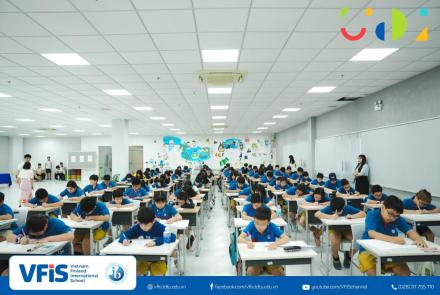Why is Finnish education still at the top of the world?
No tests, no homework, no punishment, here’s why Finnish education is still at the top of the world.
Finland has always been ranked first in math, reading and science in the PISA (Programme for International Student Assessment) rankings of the Organization for Economic Cooperation and Development.
Although, Finland has no standardized test. The only “exam” applied nationally is the national entrance exam. At this exam, students are assessed and graded by teachers who have followed them for a long time. Even if students do not want this assessment, students can completely refuse.
Besides, Finnish education does not accept the act of punishing students for mistakes or grades.
As for the homework of students in this country is very little, even none and often very interesting. For example, for a history lesson, students might be asked to ask their grandparents how life in the 1950s was different from today. Children are encouraged to rest and spend time with their families instead of doing homework.
No pressure for grades or homework, so why is Finnish education always admired by the world?

1. Teachers must meet high standards
The standards set for teachers in Finland are very high. All teachers must have a master’s degree to teach. To teach students in grades 1-6, teachers must have a master’s degree in education or higher. In order to teach students in grades 7-9, in addition to a degree in education, teachers must have a master’s degree in the discipline they teach.
The curricula have high requirements and it is not easy to enter the pedagogical schools. In 2014, only 9% of candidates who took the entrance exam to the faculty of teachers of the University of Helsinki were admitted.
In a school, if a teacher is not up to standard or does a bad job, it is the principal’s responsibility to take care of the problem.
2. Students are the center of education
In Finland, the Education Law of 1998 allows student ownership. This educational model puts the student at the center, giving the way to own and take responsibility for all his or her decisions. They can request shorter school hours, less homework, and more nutritious lunches…
In Finnish classrooms, students can choose their seats according to their preferences, freely express their opinions and are encouraged to play to their strengths.
3. Teacher and student “familiar”
Finnish schools usually have very few teachers and students. Each teacher usually teaches a group of students continuously for 6 years. During this time, teachers act as mentors, guides, and even family members. This trust and attachment helps teachers and students understand and respect each other.
No tests, no homework, no penalties, Finnish education is still at the top of the world, why is that? - Photo 1.
Each student’s needs and learning style are different, and teachers who understand those things over the years will help them map out the correct orientation for each student, creating conditions for them to achieve their goals.
4. Pressure at school is minimized
According to the Organization for Economic Co-operation and Development (OECD), Finnish students enter school from 9:45 a.m. and finish at 2:30 p.m. with the least amount of work and homework in the world, even none. Finnish students also do not have tutors, but excel in knowledge and culture thanks to a low-stress education.
Students here also attend only a few classes per day. A school day has 5 lessons (for grades 1-2) and a maximum of 7 periods for older classes. After every 45 minutes of study, the children will have a 15-minute break to exercise, entertain or relax together.
Teachers, too, have a time and place to relax, prepare for lessons, or simply socialize with colleagues.

5. Students are taught knowledge close to life
During swimming lessons, students will be taught how to spot a drowning person. When learning about house management, children are equipped with cooking, knitting and sewing skills. Nature is also an area of content that is of interest to educators.
It is important in Finnish education to prepare students with the knowledge to be able to adapt in any situation.
No tests, no homework, no penalties, Finnish education is still at the top of the world, why is that? - Photo 2.
With a highly autonomous education, schools in this country are required to each develop at least one ‘multi-disciplinary’ semester, focusing on the phenomenon or topic that students are interested in. heart.
Children participating in the above semesters will be taught about the ability to study together with many teachers at the same time, background knowledge, helping to understand the essence of the problem being discussed. This concept is also known as phenomenological learning. Teachers also assess students through interdisciplinary topics.
6. Prioritize the basics
Schools in many countries are so concerned with grades and understanding math and other natural sciences that they forget what constitutes an appropriate, equitable learning environment that keeps students happy and healthy.
Since the 80s of the last century, Finnish educators have focused on prioritizing the following core things:
Education is a tool to balance social injustice.
- All students get free meals at school.
- Ease of access to medical services and health care
- Psychological counseling
- Instructions, personalized guidance, tailored for each student
Source: CafeF




